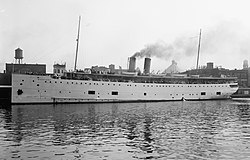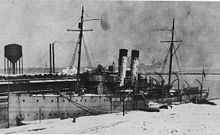Eastland (ship)
|
The Eastland
|
||||||||||||||||||||||
|
||||||||||||||||||||||
|
||||||||||||||||||||||
|
||||||||||||||||||||||
|
||||||||||||||||||||||
|
||||||||||||||||||||||
|
||||||||||||||||||||||
|
||||||||||||||||||||||
The Eastland was a American in Chicago Canada based passenger ship Michigan Steamship Company. Built by Jenks Shipbuilding Company in Port Huron, Michigan, it was mainly used for excursions. The Eastland was 265 feet (81 m) long and 12 m wide.
On May 6, 1903, was the ship on the name Eastland baptized. The godmother was Mrs. David Reid from South Haven (Michigan); She received 10 US dollars and an annual ticket for the ship's excursions.
A design flaw and its consequences
The Eastland showed the first problems with stability early on , as it had a relatively high center of gravity due to its high superstructure ( top-heaviness ). The problem was exacerbated when passengers and crew were on deck. Already on the first voyages in July 1903 this almost led to a catastrophe: The overcrowding of the deck destabilized the ship so much that water streamed into one of the gangplanks that were attached to the side of the ship. The situation was quickly brought under control, but other incidents followed. Just a month later, the aft ship was damaged when she rammed another ship while backing out. In 1906 there was another severe heeling of the ship.
In 1915, like many other ships of her time , the Eastland had been upgraded with lifeboats . As a consequence of the sinking of the Titanic with the new Federal Seaman's Act of 1915, these had become mandatory in the USA. It was precisely this measure to protect the crews and, above all, the passengers that made the problems with the stability of the ship worse. The lifeboats attached to the top of the ship added weight and shifted the center of gravity even higher. The destabilization of the ship had already assumed such critical proportions that it was necessary to limit the number of passengers for the voyages in order not to create further problems.
The downfall
On July 24, 1915, the Eastland was together with two other excursion steamers of the Great Lakes , the Theodore Roosevelt and the Petoskey , on an excursion for the Western Electric Company's Hawthorne Works from Cicero . The company's employees and workers drove to Michigan City for a picnic , a major event for the workforce who often didn't even get a vacation.
Boarding began at 6:30 a.m. on the south bank of the Chicago River and by 7:10 a.m. the ship had taken the maximum number of passengers. The ship was fully occupied with the 2751 people and many were standing tightly packed on the open upper deck when shortly afterwards the ship slowly began to heel to port, away from the quay. The crew therefore began to fill the ballast tanks in order to shift the center of gravity of the ship downwards and thus stabilize it. However, the efforts showed no effect on the ship's position.
The situation finally got out of hand when a canoe race passed the ship to port and many of the passengers ran to the railing on that side to watch the spectacle. The ship, which was already inclined in this direction, jerked sharply to port and capsized. Numerous passengers and crew members were already below deck at this point and were locked in the ship. Although the quay was only a little more than 6 meters away and immediate help was on site, 841 passengers and 4 crew members died, including a large number of children.
Many of the Eastland's victims and passengers were Czech Americans who maintained their own large community in Cicero. The only picture of their church still preserved today shows the funeral service for 29 of their parishioners who died in the Eastland disaster. Many of the victims found their final resting place in the Bohemian National Cemetery in Chicago.
Further use
The ship was lifted and auctioned in October 1915. In 1917/18 it was converted into a gunboat and put into service by the US Navy on September 20, 1918 under the name Wilmette (IX-29). In this form, she served as a training ship on the Great Lakes until the end of World War II . On November 28, 1945 she was decommissioned, deleted on December 19, 1945 from the ship's list and sold on October 31, 1946 for demolition to the Hyman Michaels Company in Chicago. The scrapping was finished in 1947.
literature
- Jay Bonansinga: The Sinking of the Eastland: America's Forgotten Tragedy , Citadel Press 2004. ISBN 0-8065-2628-9
- George Hilton: Eastland: Legacy of the Titanic , Stanford University Press 1997. ISBN 0-8047-2801-1
- Ted Wachholz: The Eastland Disaster , Arcadia Publishing 2005. ISBN 0-7385-3441-2
Web links
- Eastland Disaster Historical Society
- Maritimequest Eastland: SS Eastland Photo Gallery
- Eastland Memorial Society
- Eastland Disaster at the Center for History
- Gravesites of the victims in the Bohemian National Cemetery
- Gravesites of the victims in Concordia Cemetery



